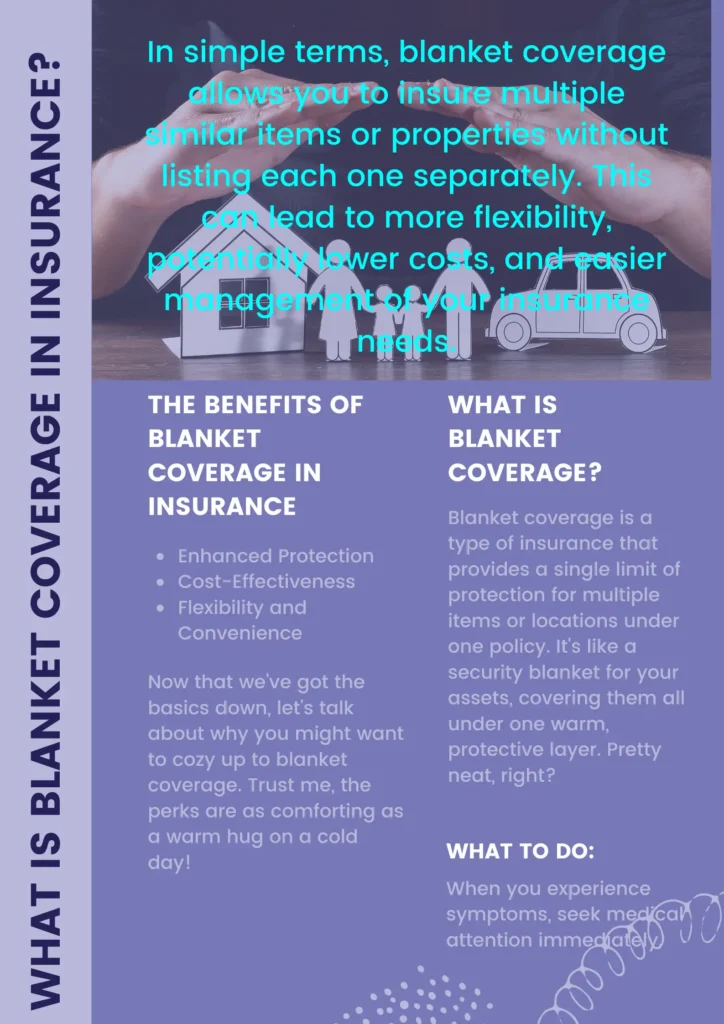What is Blanket Coverage in Insurance? It’s a type of policy that provides a single limit of protection for multiple items or locations under one umbrella.
Think of it as a cozy security blanket for your assets, wrapping them all in one layer of protection.
In simple terms, blanket coverage allows you to insure multiple similar items or properties without listing each one separately. This can lead to more flexibility, potentially lower costs, and easier management of your insurance needs.
In this article, we’ll dive deep into the world of blanket coverage. We’ll explore its benefits, types, and who might need it.

Plus, we’ll debunk common myths and provide real-world examples to help you understand if it’s right for you.
Understanding the Basics of Blanket Coverage
Alright, let’s start with the basics. What exactly is blanket coverage? Well, imagine you’re heading out on a chilly day. Instead of putting on multiple layers, you wrap yourself in one big, comfy blanket that covers everything. That’s essentially what blanket coverage does for your insurance needs!
What is Blanket Coverage?
Blanket coverage is a type of insurance that provides a single limit of protection for multiple items or locations under one policy. It’s like a security blanket for your assets, covering them all under one warm, protective layer. Pretty neat, right?
How Does Blanket Coverage Differ from Scheduled Coverage?
Now, you might be thinking, “Isn’t this just regular insurance?” Well, not quite. Let’s compare blanket coverage to its cousin, scheduled coverage:
Blanket Coverage:
- Covers multiple items or locations under one limit
- Provides flexibility in distributing coverage
- Often more cost-effective for multiple similar items
Scheduled Coverage:
- Lists each item or location separately
- Has specific limits for each item
- Can be more detailed but potentially more expensive
Think of blanket coverage as a buffet and scheduled coverage as ordering à la carte. With blanket coverage, you get a bit of everything under one price, while scheduled coverage lets you pick and choose specific items.
The Benefits of Blanket Coverage in Insurance
Now that we’ve got the basics down, let’s talk about why you might want to cozy up to blanket coverage. Trust me, the perks are as comforting as a warm hug on a cold day!
Flexibility and Convenience
One of the biggest advantages of blanket coverage is its flexibility. It’s like having a Swiss Army knife in your insurance toolkit. Here’s why it’s so handy:
- Easy management: Instead of juggling multiple policies, you’ve got one policy to rule them all.
- Automatic coverage: New purchases? No problem! They’re often automatically covered.
- Simplified renewals: Less paperwork means less hassle when it’s time to renew.
Cost-Effectiveness
Who doesn’t love saving a few bucks? Blanket coverage can be a real money-saver, especially if you’ve got multiple similar items or properties. Here’s how it can help your wallet:
- Lower premiums: Bundling coverage often leads to better rates.
- Reduced administrative costs: Less paperwork means lower processing fees.
- Economies of scale: The more you cover, the better the deal often becomes.
Enhanced Protection
Blanket coverage isn’t just about convenience and cost – it’s also about beefing up your protection. Here’s how it’s got your back:
- Higher overall limits: You get a larger pool of coverage to draw from.
- Flexibility in claim distribution: Coverage can be applied where it’s needed most.
- Peace of mind: You’re less likely to find gaps in your coverage.
Types of Blanket Coverage
Alright, now that we’ve covered the “why,” let’s dive into the “what.” Blanket coverage isn’t one-size-fits-all. It comes in different flavors, each designed to suit different needs. Let’s break it down!
Blanket Property Coverage
This is the big kahuna of blanket coverage. It’s like a protective bubble for all your stuff. Here’s what it typically includes:
- Buildings and structures
- Business personal property
- Inventory and stock
- Equipment and machinery
Imagine you own a small chain of boutiques. Instead of insuring each store separately, blanket property coverage would wrap them all up in one policy. Neat, huh?
Blanket Liability Coverage
Think of this as your shield against the slings and arrows of legal troubles. It typically covers:
- General liability claims
- Product liability
- Professional liability (in some cases)
For example, if you’re a contractor working on multiple sites, blanket liability coverage could protect you across all your projects.
Blanket Crime Coverage
This one’s all about protecting you from the bad guys. It usually covers:
- Employee theft
- Forgery
- Robbery and burglary
If you run a retail business with multiple locations, this type of coverage could be a lifesaver.
Blanket Equipment Coverage
Got lots of expensive toys? This coverage is for you. It typically includes:
- Heavy machinery
- Computer equipment
- Specialized tools
Perfect for construction companies or tech firms with lots of valuable equipment spread across different locations.
Who Needs Blanket Coverage?
Now, you might be wondering, “Is blanket coverage right for me?” Well, let’s see if you fit the bill!
Businesses with Multiple Locations
If you’re running a business empire (or even a small kingdom) with multiple locations, blanket coverage could be your new best friend. Here’s why:
- Simplified management: One policy for all locations
- Flexible protection: Coverage can shift where it’s needed most
- Cost-effective: Often cheaper than insuring each location separately
Property Managers and Real Estate Investors
Got a portfolio of properties? Blanket coverage might just be your cup of tea. Here’s how it can help:
- Easy scalability: Add new properties without hassle
- Consistent coverage: No need to worry about different policy terms
- Potential for better rates: Insurers often reward larger portfolios
Manufacturers and Distributors
If you’re in the business of making or moving stuff, listen up! Blanket coverage could be a game-changer:
- Inventory protection: Cover goods in multiple warehouses
- Equipment safeguard: Protect machinery across different facilities
- Liability shield: Guard against claims from various touchpoints
Contractors and Construction Companies
Building dreams? Make sure they’re well-protected! Here’s why blanket coverage rocks for you:
- Project flexibility: Coverage that moves with your projects
- Equipment protection: Safeguard your tools across job sites
- Liability coverage: Stay protected no matter where you’re working
How to Choose the Right Blanket Coverage
Alright, so you’re warming up to the idea of blanket coverage. But how do you pick the right one? Don’t worry, I’ve got you covered (pun intended)!
Assess Your Needs
First things first, you need to take stock of what you’ve got. Here’s a quick checklist:
- List your assets: What do you need to protect?
- Identify risks: What could go wrong?
- Consider growth: Where will you be in a few years?
Compare Policies
Not all blanket coverages are created equal. Here’s what to look for:
- Coverage limits: Make sure they’re high enough
- Exclusions: What’s not covered?
- Additional benefits: Any extra perks?
Consult with an Insurance Professional
Look, insurance can be tricky. That’s why it’s always a good idea to chat with a pro. They can help you:
- Understand policy details: No more insurance jargon headaches!
- Identify potential gaps: Make sure you’re fully covered
- Find the best deals: They know where to look for savings
Common Misconceptions About Blanket Coverage
Now, let’s clear the air about some myths floating around. Blanket coverage isn’t as straightforward as its name might suggest, and there are a few things people often get wrong.
Myth: Blanket Coverage Covers Everything
Despite its cozy-sounding name, blanket coverage doesn’t actually cover everything under the sun. Here’s the truth:
- It covers specified categories of items or risks
- There are still exclusions and limits
- It’s not a substitute for specialized policies
Myth: Blanket Coverage is Always Cheaper
While blanket coverage can often save you money, it’s not a guarantee. Here’s why:
- Depends on your specific situation: Sometimes scheduled coverage is more cost-effective
- Higher limits can mean higher premiums: You’re getting more coverage, after all
- Savings come from efficiency: Not always from lower base rates
Myth: Blanket Coverage is One-Size-Fits-All
Nope, blanket coverage isn’t a magic solution for everyone. Here’s the deal:
- Different businesses have different needs
- Some assets might require specialized coverage
- It’s important to tailor the policy to your specific situation
Pros and Cons of Blanket Coverage
Alright, let’s lay it all out on the table. Like anything in life, blanket coverage has its upsides and downsides. Let’s break it down:
Pros of Blanket Coverage
- Flexibility: Coverage can be distributed as needed
- Simplicity: Easier to manage than multiple policies
- Cost-effective: Often cheaper for multiple similar items
- Automatic coverage: New purchases often automatically included
- Higher limits: Generally provides more overall coverage
Cons of Blanket Coverage
- Potentially higher premiums: More coverage can mean higher costs
- Less specificity: Might not be ideal for unique or high-value items
- Coinsurance clauses: May require you to insure a certain percentage of total value
- Complexity: Can be harder to understand than simpler policies
- Not suitable for all situations: Some businesses might be better off with scheduled coverage
Real-World Examples of Blanket Coverage in Action
Let’s bring this all to life with some real-world scenarios. Sometimes, seeing how things play out in practice can make all the difference in understanding.
Case Study: Retail Chain
Imagine a clothing retailer with 50 stores across the country. Here’s how blanket coverage could work for them:
- Property coverage: One policy covers all store locations and inventory
- Liability coverage: Protects against customer injuries at any location
- Crime coverage: Safeguards against theft across all stores
Result: Simplified management, consistent coverage, and potential cost savings.
Case Study: Construction Company
Picture a medium-sized construction firm working on multiple projects. Blanket coverage could help them by:
- Equipment coverage: Protecting tools and machinery across all job sites
- Liability coverage: Guarding against accidents at any project location
- Property coverage: Insuring temporary structures and materials at various sites
Result: Flexible protection that moves with the company’s projects, reducing administrative headaches.
Case Study: Property Management Firm
Consider a company managing a diverse portfolio of commercial and residential properties. Blanket coverage could offer:
- Property coverage: Protecting all managed buildings under one policy
- Liability coverage: Shielding against claims from tenants or visitors at any property
- Business interruption coverage: Providing financial protection if any property becomes uninhabitable
Result: Streamlined insurance management and the ability to easily add or remove properties from coverage.
How to Make the Most of Your Blanket Coverage
So, you’ve decided to snuggle up with blanket coverage. Great choice! But how do you make sure you’re getting the most bang for your buck? Let’s dive in!
Regular Policy Reviews
Just like you wouldn’t wear the same blanket in summer and winter, your insurance needs change too. Here’s how to stay on top of it:
- Annual check-ups: Review your policy yearly
- Update asset values: Make sure your coverage reflects current replacement costs
- Reassess risks: Has your business changed? Your coverage should too
Accurate Record Keeping
Good records are like a warm cup of cocoa for your insurance – they make everything better. Here’s what to keep track of:
- Inventory lists: Know what you’ve got and what it’s worth
- Property improvements: Document any upgrades or renovations
- Claims history: Keep a record of past issues and how they were resolved
Understanding Your Policy
Knowledge is power, folks! The better you understand your policy, the more effectively you can use it. Here’s what to focus on:
- Read the fine print: Know what’s covered and what’s not
- Understand limits and deductibles: Know how much protection you really have
- Be aware of reporting requirements: Know what you need to tell your insurer and when
Conclusion: Is Blanket Coverage Right for You?
Whew! We’ve covered a lot of ground, haven’t we? Let’s wrap this up with a nice, cozy conclusion.
Blanket coverage can be a fantastic tool for simplifying your insurance and potentially saving money. It’s particularly useful for businesses with multiple locations, diverse assets, or changing inventory. The flexibility and convenience it offers can be a real game-changer for many companies.
However, it’s not a one-size-fits-all solution. Some businesses might be better served by scheduled coverage or a mix of both. The key is to carefully assess your needs, understand the pros and cons, and consult with insurance professionals to find the best fit for your situation.
Remember, the goal of insurance is to give you peace of mind, allowing you to focus on what you do best – running your business. Whether blanket coverage is right for you or not, the most important thing is that you have the protection you need when you need it.
So, take the time to review your insurance needs, ask questions, and make informed decisions. Your future self (and your business) will thank you for it!
Now, doesn’t that feel like a warm, comforting blanket of knowledge? Go forth and insure wisely, my friends!
Frequently Asked Questions About Blanket Coverage
Still got questions? No worries! Let’s tackle some of the most common head-scratchers about blanket coverage.
Q: Is blanket coverage more expensive than scheduled coverage?
A: Not necessarily! While blanket coverage often provides higher overall limits, it can be more cost-effective for businesses with multiple similar assets. The key is to compare quotes and consider your specific situation.
Q: Can I mix blanket and scheduled coverage?
A: Absolutely! In fact, this hybrid approach can be ideal for many businesses. You might use blanket coverage for your general inventory and scheduled coverage for high-value or unique items.
Q: What happens if I underinsure with blanket coverage?
A: Underinsurance can be a big problem with blanket coverage. Many policies have a coinsurance clause, which means you’re required to insure up to a certain percentage of your total asset value. If you don’t, you might face penalties when making a claim.
Q: How often should I review my blanket coverage?
A: At minimum, you should review your coverage annually. However, it’s a good idea to touch base with your insurer whenever you make significant changes to your business, like acquiring new property or expanding to new locations.
Q: Can blanket coverage replace all my other insurance policies?
A: While blanket coverage is versatile, it’s not a cure-all. You’ll likely still need other policies, like workers’ compensation or specialized professional liability insurance, depending on your business.






